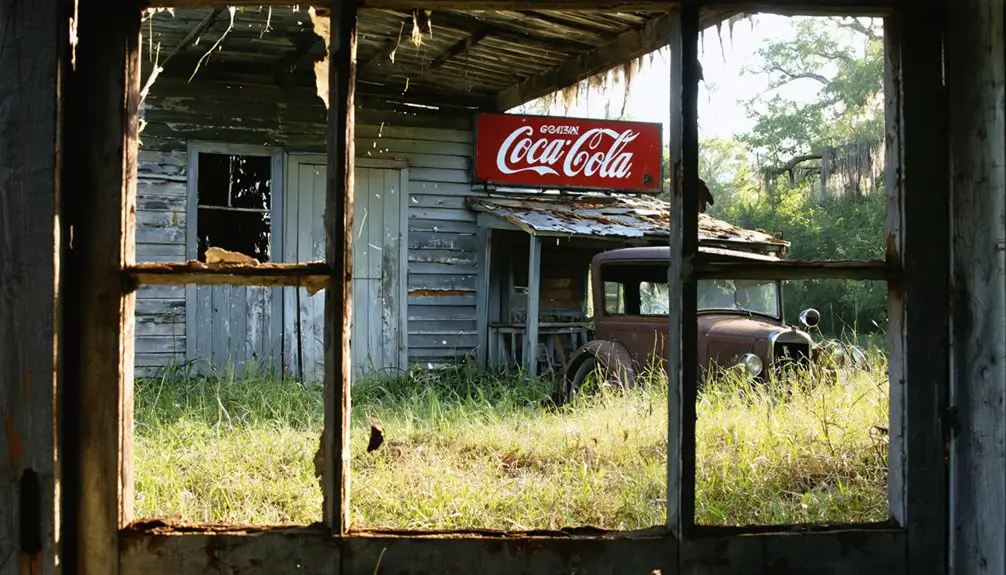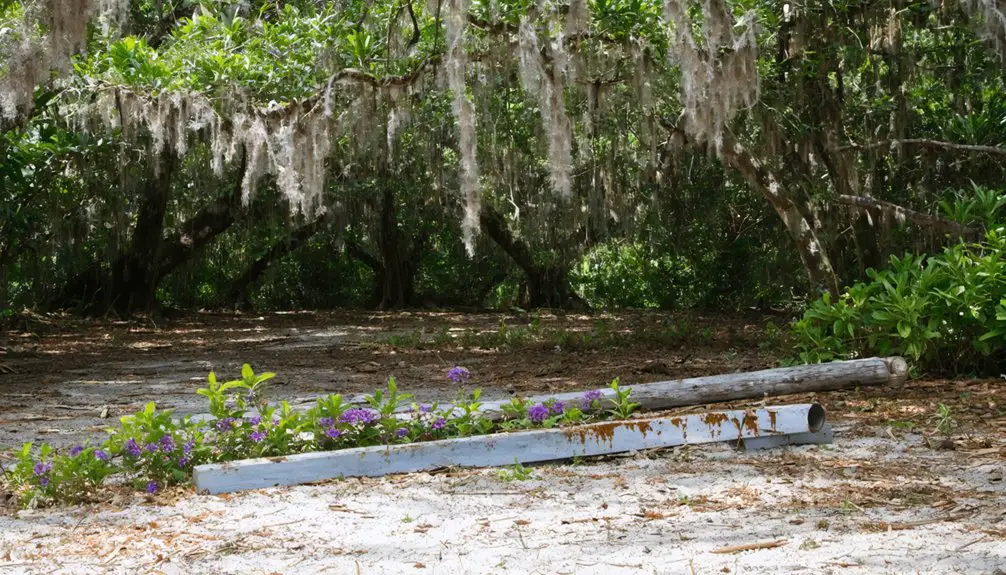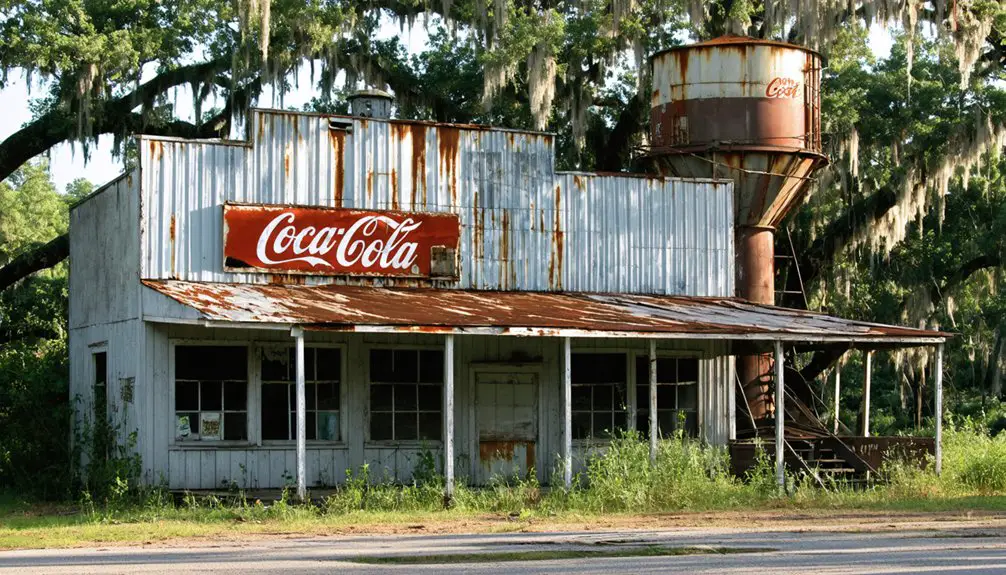You’ll find Bunce Village ghost town at the northwest edge of Florida’s Mullet Key, where Captain William Bunce established a thriving multicultural fishing settlement in 1834. The village became a sophisticated operation connecting Tampa Bay to Havana, with 150 residents including Spanish fishermen, Native Americans, and Cuban traders. Though the U.S. Army destroyed it in 1837 during the Second Seminole War, the site’s rich cultural legacy shaped Florida’s maritime heritage. The untold stories of this coastal community still echo along its unmarked trails.
Key Takeaways
- Bunce Village was established in 1834 by Captain William Bunce as a sophisticated fishing settlement at Shaw’s Point near Florida’s Manatee River.
- The multicultural settlement housed 150 residents, including Spanish fishermen, Native Americans, and Cuban traders, operating as a vital trade hub.
- U.S. Army destroyed the village in 1837 during the Second Seminole War, suspecting it harbored renegades and aided Seminoles.
- The ghost town site is located at Mullet Key’s northwest edge in Pinellas County, accessible via Route 682 and Route 679.
- No visible structures remain at the coastal location, though visitors can explore the site through an unmarked trail near the parking lot.
The Birth of a Coastal Trading Settlement
While fishing camps dotted Florida’s west coast in the early 1800s, Bunce Village emerged as a distinctive settlement when Captain William Bunce established his trading post at Shaw’s Point near the Manatee River’s mouth in 1834.
You’ll find it wasn’t just another fish camp – Bunce transformed the site into the coast’s most sophisticated fishing rancho, complete with specialized workshops and innovative fishing techniques that revolutionized local industry.
After earning his reputation in Key West’s merchant scene, Bunce strategically positioned his settlement to maximize access to rich fishing grounds and crucial trade routes to Cuba. His operation became a vital source of fresh fish and cigars for soldiers stationed at Fort Brooke.
Bunce’s keen business sense led him to choose a prime location connecting lucrative Cuban markets with Florida’s abundant coastal waters.
His vision created a bustling hub featuring permanent structures, including a store with sleeping quarters, drying racks, and specialized shops for blacksmiths and carpenters, setting new standards for coastal trading settlements.
The area would later become known as Bunces Pass, a location that remains historically significant in Florida’s fishing heritage.
Diverse Communities and Cultural Connections
You’ll find that Bunce Village emerged as a cultural crossroads where Spanish traders, Native Americans, and settlers from various backgrounds converged to form tight-knit trading networks.
The settlement’s location along Florida’s coast made it an ideal spot for Spanish-Indian commerce, reflecting similar demographic patterns seen in nearby towns like Ponce de Leon and Punta Rassa. Local tribes like the fierce Calusa people had significant influence over coastal trade dynamics before ultimately resisting European settlement attempts. By the mid-18th century, Cuban fishermen had established permanent fishing stations in the region.
These economic ties fostered rich cultural exchanges, as evidenced by the mixed heritage of many coastal communities where European, Native American, and African influences shaped daily life and trade practices.
Cultural Melting Pot Communities
Although many 19th-century Florida settlements remained culturally homogeneous, Bunce Village stood out as a remarkable multicultural hub where Spanish fishermen, Spanish-speaking Native Americans, Black laborers, Cubans, and Seminoles worked side by side.
You’ll find evidence of this cultural fusion in the 40 structures that once housed this diverse workforce, creating a unique community where different traditions blended naturally through daily interactions and economic cooperation. Captain William Bunce established this distinctive fishing village in 1837, laying the foundation for its multicultural legacy. Like modern-day Volusia County, the settlement demonstrated Florida’s rich potential for diverse community growth.
- Experience traditional fishing techniques that combined Spanish, Native American, and African influences
- Discover how multiple ethnic groups shared living spaces and cultural practices in close proximity
- Learn about the intercultural trade relationships that made Bunce Village a thriving coastal enterprise
This vibrant mix of cultures set Bunce Village apart as an early example of successful multicultural coexistence in Florida’s history.
Spanish-Indian Trade Networks
The diverse cultural fabric of Bunce Village exemplified a broader pattern of Spanish-Indian trade networks that shaped Florida’s colonial landscape.
You’ll find that Spanish treaties with West Florida tribes between 1784 and 1802 established essential trading posts where native communities exchanged pelts and livestock for European goods at fair prices. Despite facing population decline of 90% from European diseases, the Seminole maintained active trade relationships with Spanish settlers.
The Seminole trade networks proved especially dynamic, with towns like Tallahassee and Miccosukee becoming prosperous hubs. Similar to the earlier Spanish missions, these trading centers served as focal points for cultural exchange and commerce.
You’d have seen Seminole leaders working alongside Spanish colonizers, while Maroon communities of escaped slaves joined these complex commercial relationships. Together, they created thriving agricultural and pastoral operations that supplied Spanish Florida’s needs.
Through strategic fortifications and frontier outposts, Spain tried to control this trade, though their limited resources meant you could often find unauthorized commerce flourishing along places like the Apalachicola River.
Life in the Fishing Village
Located along Florida’s coast in the late 1830s, Bunce Village thrived as a diverse fishing settlement of roughly 40 structures, where Spanish fishermen worked alongside Spanish-speaking Indians, Blacks, Cubans, and Seminoles.
You’d find a bustling community of 150 workers mastering fishing techniques to supply dried and salted fish to the lucrative Havana market, earning up to $6,000 annually. Like the later settlement of Carteret County migrants, many workers would travel seasonally between fishing locations to maximize their income.
The village’s community resilience showed in its self-sufficient lifestyle and multicultural bonds, with many residents sharing Spanish language and Cuban cultural ties.
- Large-scale fish processing operations included extensive drying and salting facilities
- Workers lived in a frontier setting that demanded adaptability and resourcefulness
- Cross-cultural connections flourished, with Spanish Indians often baptized in Havana
Military Pressures and Strategic Location
You’ll find that Bunce Village faced intense military pressure during the Second Seminole War (1835-1842), as U.S. Army officials suspected the settlement of harboring renegade Spaniards and aiding Seminole resistance.
Military authorities ultimately destroyed Bunce’s Manatee River fish ranch in 1837, and his operations faced repeated disruptions due to accusations of trafficking with Seminoles.
The village’s strategic location near Fort De Soto and Tierra Verde, combined with its position along crucial maritime corridors, made it a focal point for military scrutiny and later coastal defense planning, as noted in Lieutenant Colonel Robert E. Lee’s recommendations for Mullet Key.
Military Conflicts and Tensions
Throughout Florida’s tumultuous military history, Bunce Village found itself caught in the crossfire of multiple significant conflicts, from early colonial clashes between Spanish and French forces to intense Civil War confrontations. A pivotal 1781 battle saw Spanish forces triumph over British troops and their Native American allies, marking a crucial shift in regional control.
You’ll find that military strategies shaped the village’s destiny, particularly during the Civil War when Fort Pickens became a focal point of battle, with over 5,000 artillery rounds fired in fierce bombardments.
The conflict legacies of British-Native American alliances and Seminole Wars also left their mark on the region.
- Confederate forces launched daring assaults on Federal positions at Fort Pickens before withdrawing in early 1862
- British-Loyalist troops coordinated with Choctaw allies for complex naval and ground operations
- Local settlements faced persistent threats during the Seminole Wars, requiring constant military vigilance
Strategic Defense Planning
While Robert E. Lee recognized Mullet Key’s defensive potential in 1848, you’ll find Bunce Village’s location was a double-edged sword. Its position near Tampa Bay made it perfect for coastal fortifications, but military authorities saw the diverse fishing community as a potential security risk.
You can’t overlook how the site’s proximity to Gulf shipping lanes and interior waters made it ideal for military surveillance.
When combined with Florida’s extensive military airspace and training areas today – including the 180,000-square-mile Joint Gulf Range Complex – you’ll understand why this region remains essential for defense.
The Army’s decision to destroy Bunce Village reflected a broader strategy of eliminating potential enemy hiding spots along the Gulf Coast, prioritizing military control over civilian settlement in this strategically important area.
The Final Days of Bunce Village

As military concerns intensified in the mid-19th century, Bunce Village faced mounting pressure from U.S. authorities who saw the settlement as a potential security risk.
The decline factors accelerated after Robert E. Lee’s 1848 recommendation to use Mullet Key for coastal defense.
Lee’s 1848 proposal to fortify Mullet Key hastened the village’s downfall as military priorities overtook civilian settlements.
You’ll find that this once-thriving multicultural community of 150 residents couldn’t withstand the growing military and political control over Florida’s coast, leading to its eventual destruction.
- A vibrant mix of Spanish fishermen, Indians, Black workers, and Cubans lived harmoniously at the village.
- The community maintained its distinct Spanish-speaking cultural legacy despite pressure to conform.
- Strategic location at Bunce Pass sealed the settlement’s fate as a perceived threat.
The village’s destruction marked the end of traditional fishing settlements in the area, leaving no physical traces behind.
Historical Impact on Florida’s Maritime Heritage
Under Captain William Bunce’s leadership, Bunce Village played a pivotal role in shaping Florida’s early maritime economy and cultural landscape. His maritime innovations established one of Florida’s first international fishing operations, connecting Tampa Bay’s waters directly to Havana’s markets.
You’ll find that Bunce’s approach to economic sustainability was remarkably forward-thinking – he created a diverse workforce of 150 people, including Spanish fishermen, Black workers, Cubans, and Seminoles.
The fishing rancho didn’t just serve as a commercial hub; it fostered cultural exchange and trade between various ethnic groups, proving that maritime success didn’t require homogeneity.
While the U.S. Army’s destruction of Bunce Village in 1837 disrupted this thriving enterprise, its legacy lives on in Florida’s enduring multicultural maritime heritage.
Finding the Ghost Town Today

Located at the northwest edge of Mullet Key in Pinellas County, Florida, Bunce Village‘s ghost town site requires careful navigation to reach.
You’ll need to take Route 682 from Saint Petersburg to Route 679, a toll road leading south to Mullet Key. At the end of Route 679, you’ll find a loop near a parking lot with an unmarked trail to the site.
- No visible structures remain at this remote coastal location
- GPS or local knowledge is essential for ghost town exploration
- The site offers a unique glimpse into Florida’s maritime past
While there aren’t any physical remains to see, you can explore the natural coastal terrain where this historic fishing village once stood.
The best navigation tips include following the unmarked trail from the parking loop and visiting during cooler months to avoid intense heat exposure.
Frequently Asked Questions
What Was Captain William Bunce’s Relationship With the Spanish Government?
You’ll find that Bunce’s trade network operated independently from Spanish rule, though he maintained cultural ties through his Spanish workforce and fishing practices rather than through direct Spanish diplomacy.
How Did Villagers Manage Fresh Water Supplies on Mullet Key?
Like water-hungry survivors, you’d rely on rainwater collection in barrels and cisterns, dig shallow wells into freshwater lenses, practice strict conservation methods, and occasionally import water from the mainland during shortages.
What Types of Boats and Fishing Equipment Were Used?
You’d find smacks, sloops, and canoes equipped with seining nets and hooks for fishing techniques. By the 1940s, motorized skiffs joined the fleet, all used for nearshore fishing and transport.
Did Any Original Inhabitants Relocate to Other Fishing Villages?
Ever wonder where native communities went? You’ll find that original inhabitants likely scattered to Cuban and Florida coastal fishing villages, though records don’t tell us exactly where each group ended up.
Were There Any Significant Natural Disasters That Affected Bunce Village?
While you’ll find evidence of hurricane impact and flooding events in nearby Pinellas County areas, there’s no direct documentation of specific natural disasters affecting Bunce Village in the available historical records.
References
- https://www.visitsierraleone.org/slave-trade-ghost-town-the-dark-history-of-bunce-island/
- https://www.journaloffloridastudies.org/0102ghosttowns.html
- https://www.ghosttowns.com/states/fl/buncevillage.html
- https://en.wikipedia.org/wiki/Fishing_ranchos
- https://www.ponce-inlet.org/295/Town-History
- https://core.ac.uk/download/pdf/401880834.pdf
- https://www.tampabay.com/archive/1991/04/22/history-of-bunce-s-pass-filled-with-fish-stories/
- https://stars.library.ucf.edu/cgi/viewcontent.cgi?article=2246&context=fhq
- https://ldhi.library.cofc.edu/exhibits/show/africanpassageslowcountryadapt/sectionii_introduction/africans_in_carolina
- https://en.wikipedia.org/wiki/Ponce_de_Leon



